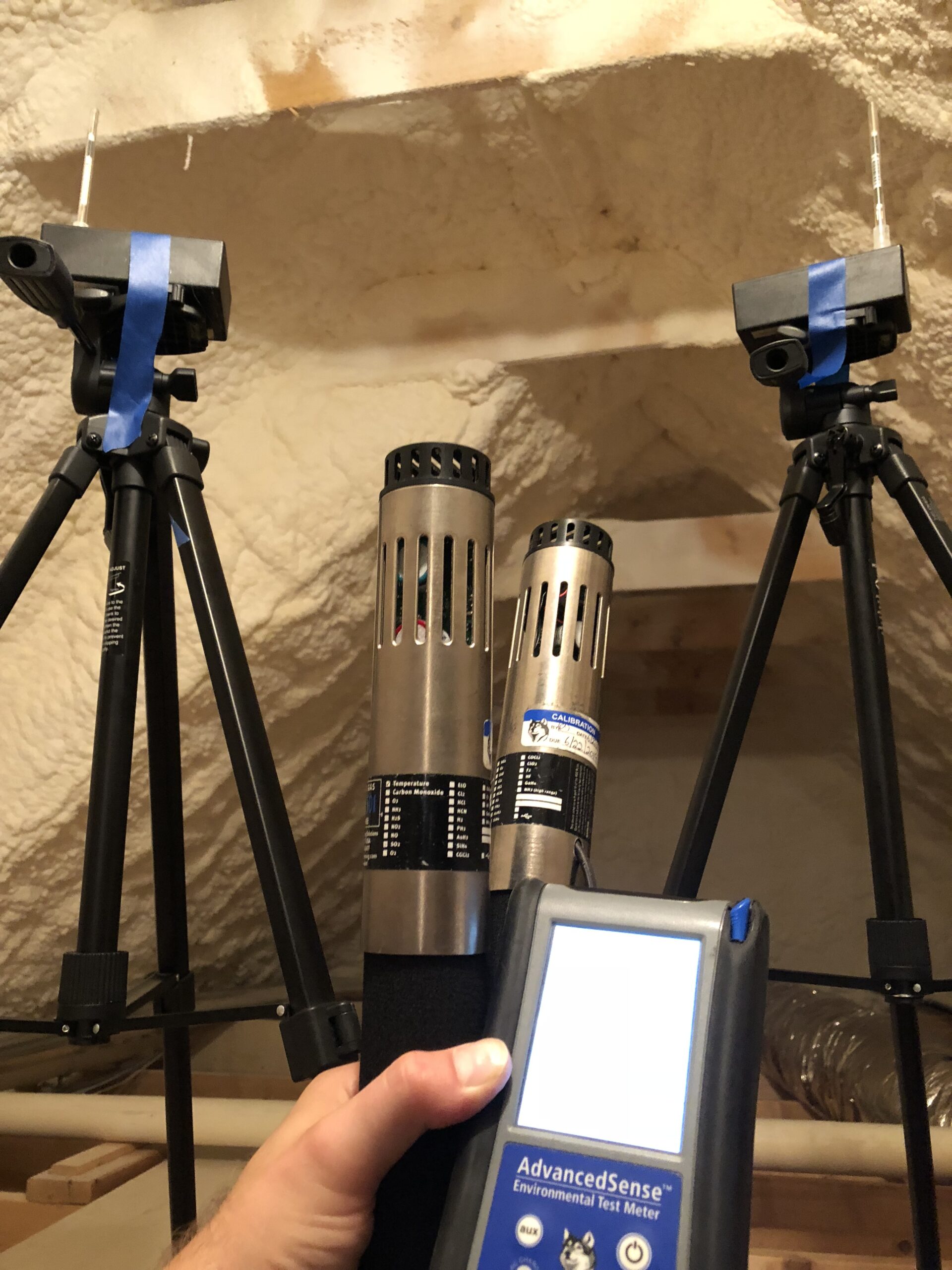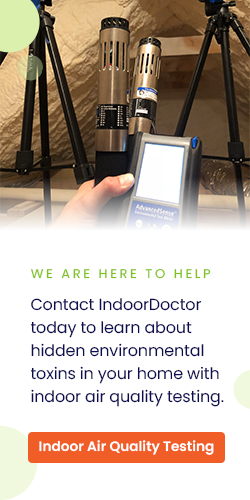While spray foam insulation offers numerous benefits, it’s crucial to assess the potential risks associated with the accumulation of spray foam dust. This blog delves into how spray foam dust can gather on surfaces, infiltrate HVAC systems, and pose health hazards when inhaled. We explore particulate matter’s toxic properties and spray foam dust’s bioaccumulation.
Discover the significance of having your home inspected for spray foam dust and the importance of proper remediation techniques, including specialized HEPA vacuuming and air duct cleaning. We also address potential pitfalls of spray foam insulation and provide links to further resources. Stay informed, test for harmful VOCs and particulates, and safeguard your home and health.
Understanding Spray Foam Dust
After a spray foam insulation project, it’s essential to grasp the concept of spray foam dust and its potential implications. When spray foam is installed, microscopic particles can be released into the air and settle on various surfaces, including within HVAC systems and air ducts. These particles, known as spray foam dust, can threaten indoor air quality and human health.
Spray foam dust consists of small particles and fragments of cured foam insulation. When these particles become airborne, they can easily be inhaled. Once inhaled, they can irritate the respiratory system and exacerbate conditions such as asthma and allergies. The size and composition of spray foam dust particles make them capable of penetrating deep into the lungs, causing respiratory distress and discomfort.
Particulate matter, including spray foam dust, is known for its toxic properties. It may contain harmful chemicals, such as isocyanates, flame retardants, and blowing agents used in manufacturing. These chemicals can harm human health, including respiratory issues, skin irritation, and potential long-term health risks.
Further, spray foam dust has the potential to bioaccumulate within the body over time. This means repeated exposure to these particles may increase harmful substances’ buildup, further exacerbating health concerns.
Understanding the risks associated with spray foam dust is crucial for homeowners. Proper ventilation, regular cleaning, and professional remediation using specialized techniques such as HEPA vacuuming and air duct cleaning can help minimize spray foam dust and improve indoor air quality.
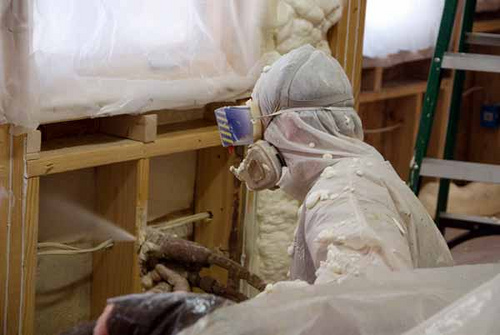
Importance of Inspection and Remediation
When spraying foam dust in your home, thorough inspection and proper remediation are of utmost importance. Inspection plays a crucial role in identifying the accumulation of spray foam dust in various areas, such as surfaces, HVAC systems, and air ducts. Trained professionals can assess the extent of the dust accumulation and determine the appropriate course of action. Through inspection, potential health risks associated with spray foam dust can be identified, allowing for targeted remediation efforts.
Remediation, including specialized techniques like HEPA vacuuming and air duct cleaning, is essential for safely removing spray foam dust. Professionals with the necessary tools and expertise can effectively remove dust particles, minimizing their presence in your home. Properly remedying the situation can improve indoor air quality and reduce the risk of respiratory irritation and other health issues caused by spray foam dust.
A key benefit of professional remediation is the utilization of HEPA (High-Efficiency Particulate Air) filtration. HEPA filters are designed to capture tiny particles, including spray foam dust, ensuring thorough removal and containment. This specialized equipment and appropriate cleaning methods help to safeguard your home and maintain a healthier living environment.
By prioritizing inspection and remediation, you can effectively address the potential health risks associated with spray foam dust. Consulting with professionals specializing in spray foam remediation ensures that the process is carried out with expertise and adherence to safety protocols. Take proactive steps to protect your home and your health by addressing spray foam dust through proper inspection and remediation techniques.

Pitfalls of Spray Foam Insulation
While spray foam insulation is renowned for its exceptional performance, it’s crucial to be aware of potential pitfalls associated with its installation and long-term use. Understanding these drawbacks can help homeowners make informed decisions and explore alternative insulation options when necessary.
Improper installation is one common pitfall of spray foam insulation. If not applied correctly, it can lead to air leaks and inadequate coverage, compromising the insulation’s effectiveness. Incomplete sealing can result in thermal bridging and energy inefficiency, reducing the expected benefits of spray foam insulation. Another consideration is the permanence of spray foam insulation. Once applied, it can be challenging to remove or modify without significant effort and cost. This lack of flexibility may pose challenges when renovating or changing the building’s structure or insulation needs in the future.
Additionally, there have been concerns regarding releasing volatile organic compounds (VOCs) during installation. VOCs are chemicals that are emitted as gasses and may contribute to indoor air pollution. While modern spray foam products have low VOC content, ensuring proper ventilation during and after installation is vital. Some individuals may also experience allergic reactions or respiratory discomfort due to the chemicals present in spray foam insulation. The off-gassing of certain compounds during the curing process can irritate sensitive individuals or those with pre-existing respiratory conditions.
Consulting with insulation professionals can provide valuable insights and guidance in selecting the most suitable insulation solution for a home.
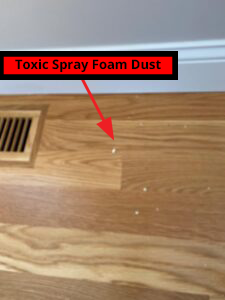
Testing for Spray Foam Dust and Harmful VOCs
It is important to consider testing for spray foam dust and harmful volatile organic compounds (VOCs). Here’s why testing is crucial:
- Identifying Spray Foam Dust
Testing allows for the detection of spray foam dust particles that may have accumulated in various areas of your home. By assessing the presence and concentration of these particles, you can determine the need for remediation and take appropriate measures to improve indoor air quality.
- Assessing VOC Levels
VOCs are chemicals released from spray foam insulation during and after installation. Testing for VOCs helps evaluate the air quality in your home and detect any potentially harmful substances. This information is vital for understanding the overall health impact of spray foam insulation and making informed decisions about its use.
- Ensuring Proper Remediation
Testing provides a baseline assessment before and after remediation efforts. It helps determine the effectiveness of remediation procedures in reducing spray foam dust and VOC levels, ensuring that the necessary steps have been taken to create a safer living environment.
- Protecting Occupant Health
Testing for harmful VOCs and spray foam dust helps safeguard the health of occupants. By identifying potential risks and sources of exposure, appropriate actions can be taken to mitigate any adverse health effects and improve indoor air quality.
Remember, testing for spray foam dust and harmful VOCs is a proactive step towards maintaining a healthy home environment and ensuring the well-being of you and your loved ones.
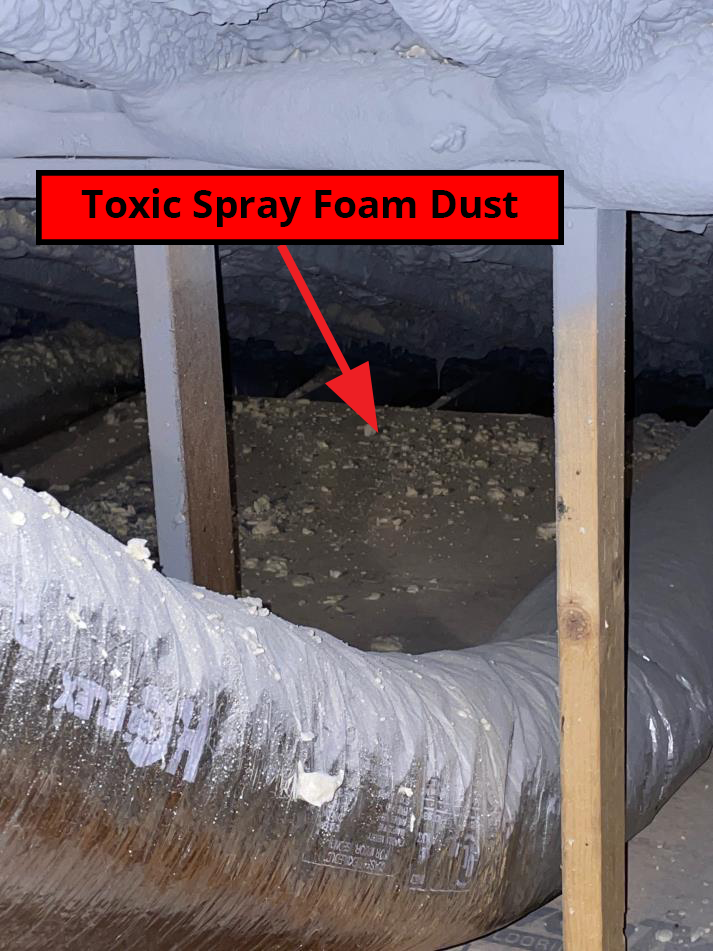
Address Your Spray Foam Insulation Today
Proactively addressing the potential risks associated with spray foam insulation is essential for maintaining a safe and healthy home. Testing for spray foam dust and harmful VOCs and proper inspection and remediation are crucial steps toward achieving this goal.
IndoorDoctor, with our expertise in indoor air quality assessment and remediation, can provide valuable assistance in identifying and addressing spray foam-related concerns. Take control of indoor air quality and trust IndoorDoctor to help you breathe easier.
References
- Berkeley Analytical. (n.d.). Spray Polyurethane Foam
- Laborers’ Health and Safety Fund of North America. (n.d.). The Dangers of Using Spray Foam Insulation
- U.S. Consumer Product Safety Commission. (n.d.). Spray Polyurethane Foam Insulation: Health and Safety Recommendations for Consumers
- U.S. Environmental Protection Agency. (n.d.). Potential Chemical Exposures from Spray Polyurethane Foam


